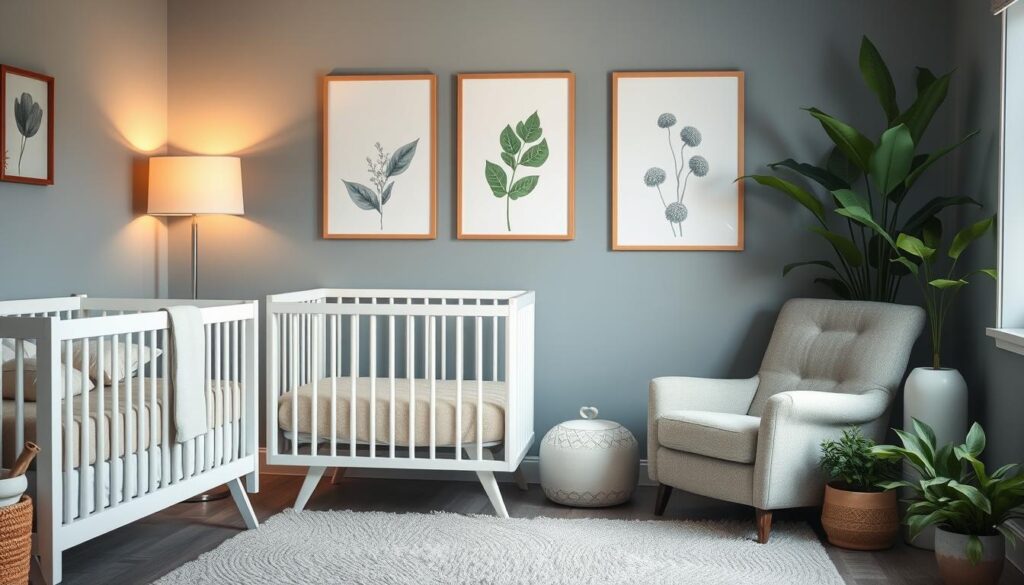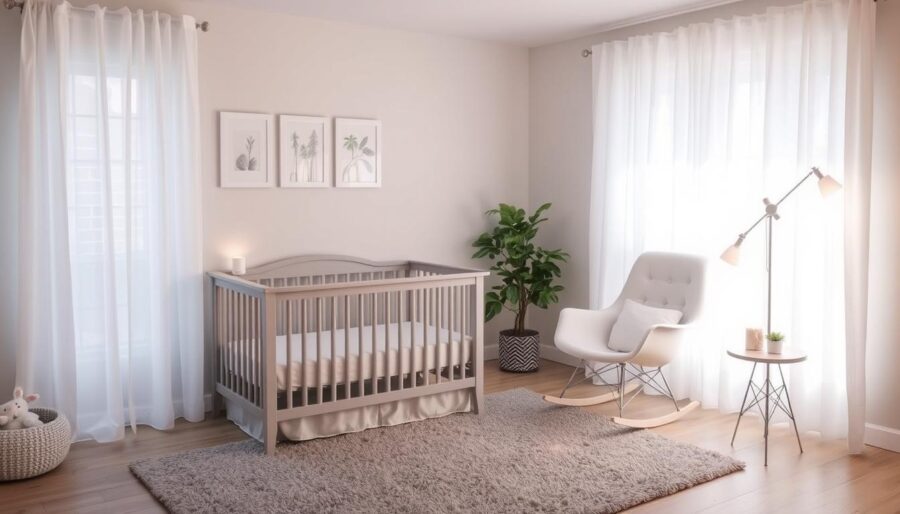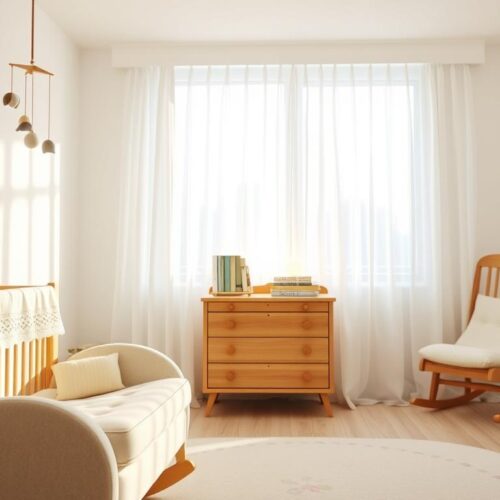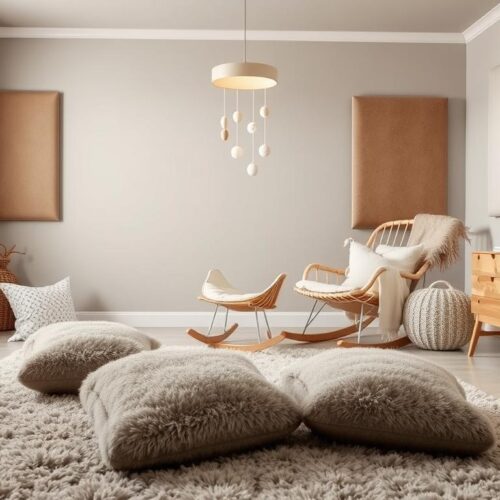Making sure your baby sleeps in a calm place is key for good sleep. A peaceful room helps them rest well at night, cutting down on wake-ups. Here are important tips for setting up a calm space that helps your baby sleep better.
Importance of a Calm Sleep Environment for Babies
Creating a calm sleep space is vital for your baby’s health and growth. A peaceful area helps decrease sleep disruptions, leading to better sleep habits. This improvement supports your baby’s physical and emotional development.
To make a baby’s sleeping area calm, you can follow some simple baby sleep tips. Stick to a regular bedtime, use soft lights, and keep the room at a comfortable temperature. A quiet room also helps by reducing noise that could wake the baby.
By using these tips, you’ll make a tranquil place for your baby to sleep. This not only improves sleep quality but also sets up good sleeping patterns for the future. Paying attention to what your baby needs is crucial for a perfect sleeping environment.
| Elements | Impact on Sleep |
|---|---|
| Gentle Lighting | Reduces overstimulation |
| Quiet Atmosphere | Minimizes disturbances |
| Optimal Room Temperature | Enhances comfort |
| Consistent Bedtime Routine | Promotes regular sleep patterns |
A calm sleep environment is key for restful sleep in babies. Paying attention to their sleep area can boost their sleep quality and health.
Choosing the Right Crib or Bassinet
When picking a cozy nursery setup, the right crib or bassinet is key for your baby’s comfort and safety. Each option offers unique benefits for different needs and tastes.
For crib safety, it’s vital the crib meets the latest safety standards. Look for a solid frame, correct slat spacing, and tight mattress fit. These contribute to a safe sleeping area for your baby, reducing risks and supporting good sleep.
Here’s a comparison to help you choose between a crib and a bassinet:
| Feature | Crib | Bassinet |
|---|---|---|
| Size | Standard (larger footprint) | Compact (smaller footprint) |
| Longevity | Can be used up until toddler years | Good for the first few months only |
| Portability | Usually stays in one place | Can be moved easily |
| Cost | More expensive typically | Usually cheaper |
Whether you go for a crib or a bassinet, make sure it makes your nursery calming. It should offer a snug sleep spot for your baby, ensuring their safety and happiness.
Creating a Dark Room
Making the perfect dark room for your baby’s sleep is really important. A dark room tells your baby it’s sleep time, which can make bedtime routines smoother. To make a calming nursery, it’s not just about dim lights. It also involves choosing the right blackout curtains, light-blocking shades, and room colors.
Here’s a table comparing options for creating a dark room for baby sleep:
| Component | Description | Benefits |
|---|---|---|
| Blackout Curtains | Heavy fabric curtains designed to block all incoming light | Optimal darkness, enhances sleep quality |
| Light-Blocking Shades | Window coverings that can be adjusted to block out light entirely | Flexibility in light control, energy-efficient |
| Dark Wall Colors | Deep, calming shades on the walls | Creates a cocoon-like atmosphere, soothing for babies |
| Soft Nightlight | Minimal light source that can be dimmed | Provides comfort without disrupting sleep |
By including these features, you’ll make a peaceful nursery. This helps with a calming bedtime routine and better sleep quality. A dark room improves your baby’s sleep cycles and health, helping them grow and develop well.
The Role of White Noise
Creating a calm sleep space for babies helps them sleep better. Many parents use white noise to improve their baby’s sleep. It effectively reduces chances of babies waking up from sudden noises.
Baby sleep tips often recommend white noise machines or apps. They make steady, calming sounds like rain or ocean waves. White noise helps babies by covering up other sounds. This lets them fall asleep more easily and stay asleep longer.
Using white noise for babies in their sleep routine has many benefits. It makes a soothing atmosphere and a safe feeling. This is key for a peaceful sleep for babies.

Optimal Room Temperature
Keeping the right optimal nursery temperature is key for your baby’s well-being and sleep. The best temperature for a comfortable baby sleep space is between 68-72 degrees Fahrenheit. If it’s too hot or too cold, your baby may not sleep well, feeling uncomfortable.
- Use a room thermometer to check the temperature often.
- Change clothes and bedding based on the temperature.
- If needed, use a fan or heater, but make sure they’re safe for babies.
By keeping the temperature just right, you help your baby sleep peacefully. This comfortable baby sleep space is also good for their health. It ensures they sleep well and lowers the chance of getting too hot or too cold.
Safe Bedding Practices
Creating a safe sleep area for your baby is key to their health. It’s important to focus on safe baby bedding. This ensures proper crib safety, preventing dangers and giving you peace of mind.
Start with choosing the right mattress for a soothing nursery. It needs to be firm and fit the crib perfectly, leaving no gaps. You should not use soft items like pillows, comforters, or plush toys in the crib. These items could increase the risk of suffocation.
Also, a fitted sheet that snugly fits the crib mattress is essential. Avoid loose bedding because it’s hazardous. To enhance crib safety, always place your baby on their back to sleep. This lowers the chances of Sudden Infant Death Syndrome (SIDS).
Keeping the crib area tidy and free from clutter is part of creating a soothing nursery. Always check the crib for broken or loose parts. Make sure to fix or replace them to keep the environment safe.
Swaddling Techniques
Swaddling can help your baby sleep better. Proper swaddling makes for a calm sleeping area, improving rest quality.
Knowing how to swaddle right is key for better sleep. Here are some tips for safe, sound baby sleep:
- Spread a blanket flat and fold down one corner.
- Lay your baby face-up with their head above the folded corner.
- Straighten your baby’s left arm and wrap the left side of the blanket over their body, tucking it between their right arm and right side.
- Bring the bottom corner up over the baby’s feet and tuck it under the chin.
- Straighten the right arm and wrap the right side of the blanket over their body, tucking it underneath on the left side.
These steps create a peaceful sleep space for your baby, aiding in better rest. Make sure the swaddle is snug yet allows movement in hips and legs.
Using a Baby Monitor
A baby monitor adds multiple benefits to your infant’s sleep environment. It lets you watch your baby’s activity and breathing all night. This added security gives you peace of mind. It makes bedtime smoother for you and your baby.
Modern baby monitors are packed with helpful features. They have video, temperature sensors, and two-way audio. This makes it easy to keep your baby comfortable without waking them. These features send you alerts right away, which keeps your baby’s sleep just right.
A baby monitor can also work with other smart devices in your home. For example, you can link it to your smartphone. This way, you get updates no matter where you are in the house.
Using a baby monitor boosts the safety and comfort of your baby’s sleep area. It helps you keep bedtime peaceful by reducing your worry. This means you can quickly meet your baby’s needs.
Choosing the Right Lighting
For a peaceful nursery, picking the right lighting matters a lot. A good nightlight for babies offers soft light. It’s not too bright or too dark. This helps your baby feel safe and comfy.
Looking for an adjustable nightlight is wise. Many nightlights let you change the brightness. This way, you can make the light just right for your baby. The light’s color is also key. Choose warm colors like amber. They disturb sleep less than cool colors like blue.
Creating a calm nursery means using different lights together. You can use a ceiling light and a lamp with a dimmer. This lets you change the room’s feel any time. Such setup makes sure your baby’s sleep area is cozy, day or night.
| Type of Light | Recommended Usage |
|---|---|
| Nightlight for Babies | Provides gentle illumination, ideal for nighttime comfort and security. |
| Ceiling Light | Overall room lighting, best for daytime use and diaper changes. |
| Table/Floor Lamp | Offers adjustable lighting options, creating a cozy and flexible atmosphere. |
The right lighting makes your baby’s sleep space cozy. With careful choices, you can improve your baby’s sleep a lot.
Avoiding Stimulating Activities Before Bed
Having a calm bedtime routine is key for your baby’s good sleep. Try not to do things like rough play, TV watching, or using gadgets an hour before bed. These can make your little one too excited to sleep well. Instead, go for soothing stuff like gentle rocking, reading a bedtime story, or a warm bath. These help your baby relax and sleep better.
A peaceful place to sleep is very important too. Keep your baby’s room dim and quiet to help them rest. Below is a table with tips on what to avoid and what to do for bedtime.
| Activity | Effect | Recommendation |
|---|---|---|
| Vigorous Play | Increases adrenaline, making it harder to sleep | Avoid an hour before bedtime |
| Watching TV | Stimulates the brain, delaying sleep onset | Limit screen time, especially before bed |
| Gentle Rocking | Soothes and calms the baby | Incorporate into the bedtime routine |
| Bedtime Story | Encourages relaxation and bonding | Read a story every night |
| Warm Bath | Relaxes muscles and mind | Give a bath 30 minutes before bedtime |
By following these baby sleep tips and making sure the nursery is calming, your baby will start to have a better sleep cycle. And everyone gets to rest more peacefully at night.
Promoting Consistent Sleep Routines
Setting up a baby sleep schedule is key for peaceful sleep. With structured routines, you create a familiar setting. This tells your baby it’s time to relax.
To build a regular bedtime routine, try these steps:
- Pick a fixed bedtime and waking time to stabilize the baby’s sleep cycle.
- Add soothing activities like a warm bath, soft rocking, or reading a story.
- Make sure the nursery is quiet and calming for sleep.
Making changes to the sleep area is also crucial for your baby’s sleep. Using soft lights and quiet before bed helps create a calm space.
A steady night routine and a comfy sleep environment make falling asleep easier. These steps not only help set a sleep schedule but also ensure peaceful sleep for babies.
Comfortable Baby Sleep Space
Creating a cozy place for your baby to sleep is key to their happiness and good sleep. The main aim is to make a calming room that helps your baby sleep well. This means adding things that make the room comfortable, safe, and peaceful.

First, choose a crib or bassinet that’s safe and snug. Make sure the mattress is firm and fits right in the crib. Don’t put soft toys or loose blankets in the crib because they can be dangerous.
The room’s feel is important, too. A calming nursery should have relaxing colors, dim lights, and soft noises. Use blackout curtains for darkness during naps and a white noise machine to block annoying noises.
Keeping the room at the right temperature is also key. The best temperature is between 68°F and 72°F for a cozy sleep space. Dress your baby in the right clothes so they’re comfy but not too hot.
Finally, keep the room tidy to make sure your baby has room to sleep and move safely. A clean nursery means you can find what you need quickly and keeps the sleep area calm.
Calm Sleep Environment for Babies
Creating a peaceful place for babies to sleep is key for their growth and happiness. A calm bedtime routine helps babies sleep better and without waking up often. You can make the sleep space serene with some simple steps.
First, think about the room’s feel. Use soft light to make a cozy and calm setting, which is very important. Bright lights should be avoided at bedtime because they might keep your baby awake.
Using white noise machines is a great idea too. They give a steady sound that blocks out house noise, making bedtime more peaceful. Just make sure the sound is not too loud for your baby’s ears.
It’s also key to keep the room at the right temperature. The room should be cool, around 68-72°F, so your baby doesn’t get too hot or too cold during the night.
Last, the right bedding matters a lot for a restful sleep. Choose soft, breathable sheets and safe sleepwear to keep your baby comfortable and warm all night.
| Factors | Importance |
|---|---|
| Soft Lighting | Creates a soothing atmosphere |
| White Noise | Masks household noises |
| Optimal Room Temperature | Prevents temperature-related sleep disruptions |
| Safe Bedding | Ensures comfort and safety |
Conclusion
Creating a calm sleep space for your baby is more than just rest. It’s making sure they feel safe and loved. This guide showed you how, from picking the right bed, setting the room temp, to safe bedding and white noise benefits. All these help your baby sleep better and feel secure.
Adding swaddling and a good baby monitor improves their comfort and safety. Keeping lights low and calming before bed helps too. Keeping a regular sleep pattern is crucial. It improves sleep quality and makes bedtime smooth for you and your baby.
These tips aim to help your baby sleep well in a nurturing environment. By using these methods, you prepare them for lasting good sleep habits. Here’s to peaceful nights and sweet dreams for your little one!




